
Hiking Dude Blog
2025 - Aug Jul
2024 2023 2022 2021 2020 2019 2018 2017 2016 2015 2014 2013 2012 2011
12/05/2011
Cairns
 I'd like to elaborate on two points that came up in the comments of my last post - and thank you for all your thoughts.
I'd like to elaborate on two points that came up in the comments of my last post - and thank you for all your thoughts.Cairns vs. Art
Some people mentioned that rock cairns are useful for marking the trail so the rock stack I found should be left alone. The rock stacks were most definitely NOT cairns. The trail is manicured and so encompassed by forest that a person would need to work at getting off the trail.
Rock Art does not adhere to the ethics of Leave No Trace. Some of the specific LNT items to consider are:
- Use a map and compass to eliminate the use of marking paint, rock cairns or flagging.
- Leave rocks, plants and other natural objects as you find them.
- Do not build structures, furniture, or dig trenches.
- Respect other visitors and protect the quality of their experience.
If a person subscribes to the LNT philosophy, then piling rocks isn't something that person would do. It is something we should be teaching youth not to do when we have the opportunity.
There is certainly a place for rock art, and nature art in general. Some people make a living from it - see Andy Goldsworthy. But, we shouldn't be building artworks in the wild, or on public lands, and leaving them for others to observe after our hike.
Building Cairns
Cairns are definitely useful in some areas. Many land management groups build and maintain cairns to mark the trail, similar to blazes on trees. For example, see this cairn construction page. A group spends time removing unofficial cairns and rock art to improve the usefulness of the maintained cairns.
In a pristine environment, hikers should have the opportunity to feel like they are the first explorers. No trail markings are needed through an area with no trail. Cairns in a pristine area may concentrate traffic to a specific path, creating a trail counter to LNT philosophy, rather than dispersing traffic to keep the area pristine.
In an area with established trails, cairns or blazes made by the responsible land agency are adequate. Individuals adding to them can cause confusion and unneeded visual impact.
Here are a couple other pages you might review - Leave what you find, LNT Blog
If you are a proponent of LNT, please take care in how the philosophy is shared with others. You can do it reasonably in an effort to help others understand the value, or this way - http://www.youtube.com/watch?v=Jdfr9x8M8Vw
Hike On
Leave Comment
Posted: 12/05/2011
Posted: 12/05/2011
12/14/2011
The Cold Won't Kill Ya ...
 On this hike, it was 5 degrees - see the frost all over my head? :-)
On this hike, it was 5 degrees - see the frost all over my head? :-)I've decided 5 degrees is about as cold as I enjoy being out hiking miles. Colder and the layers of clothes make walking less enjoyable. But, down to 5 and my trail shoes, longjohns and nylon pants, fleece jacket and rain coat, mittens, hat, and scarf work perfectly without being overly bulky. This week it's popped back up to 40 with mist and fog so I've got at least a few more days to hike.
In wilderness first aid, we discuss what time of year is the most dangerous for hypothermia. When your body loses more heat than it can generate for long enough, your core temperature drops, resulting in hypothermia. Often, the first thought right out of the gate is 'January!' but then we chat a bit.
Hypothermia can happen any time of year, but the colder the temperature gets, the faster your body loses heat. So, January makes sense. But, in the dead of winter around here with -20° days, we expect cold so we wear parkas, mukluks, mittens, and balaclavas to insulate us. Besides that, and just as important, everything is frozen solid - that means it's not wet. You can hike through miles of snow and stay completely dry.
Staying dry is a great defense against hypothermia. Hiking at a steady rate without working up a sweat, dressing in layers, ventilating your clothes, and wearing rain gear are all good ways to minimize moisture on your skin. Water transfers heat 50+ times as much as air.
So, spring and fall tend to have more wet weather. Which is worse?
After warm summer days, a wet Fall day feels cold so we protect ourselves. A 35 or 40 degree day in Spring feels tropical and people are tempted to go out with inadequate protection - especially youth. When they get wet, real trouble can happen quickly.
Whether heading out for an afternoon hike or a long trek, staying warm and dry should be part of your preparation.
The cold won't kill ya - the wet will.
Hike On
Leave Comment
Posted: 12/14/2011
Posted: 12/14/2011
12/31/2011
Resolve
 Another year about to begin - endless possibilities and opportunities ahead. Over the holidays, I've been enjoying time with relatives and away from computers. I got in a couple 15-mile hikes in the snow, received a few very cool hiking/camping items, and ate way too much. I'll tell you more about the first two next week. I even made two sets of moccasins for gifts and have one more to do today.
Another year about to begin - endless possibilities and opportunities ahead. Over the holidays, I've been enjoying time with relatives and away from computers. I got in a couple 15-mile hikes in the snow, received a few very cool hiking/camping items, and ate way too much. I'll tell you more about the first two next week. I even made two sets of moccasins for gifts and have one more to do today.It's always a good thing to take some time to reflect on what you've accomplished and make goals you'd like to attain. January 1 is a perfect date to do this, being sort of a reboot of time each year. Being resolute is a characteristic of good leadership and self-discipline - defining success and then pushing ahead until success is reached.
If you've not made any new year's resolutions yet, take ten minutes and jot down a few so you can check your progress over the year. Here's a couple of mine:
- Walk 3000 miles - that's 800 on the AZ Trail, 1100 on the Ice Age Trail, and 1100 on conditioning hikes.
- Blog 300 times - this will be the most difficult
- Make 30 new friends - not Facebook friends, real people. I hope to meet them on the trail, at presentations, church, and in business.
Now, I need to set my resolve and make these more than just wishes.
Hike On
(and have a Happy New Year)
Leave Comment
Posted: 12/31/2011
Posted: 12/31/2011
01/03/2012
Who Does That?
 What do cigarettes, guns, spray paint, knives, and rocks have in common?
What do cigarettes, guns, spray paint, knives, and rocks have in common?They account for the majority of vandalism and litter I see on the trail and at trailheads. I often wonder what person does this. Maybe I know him. Maybe he's a friend of mine.
This Ice Age Trail route sign is a perfect example of someone with a gun, boredom, and low braincell counts. OK, that wasn't very nice, but really? I mean, Come On!
This was at a point where the trail crosses a fairly remote dirt road and that small yellow sign makes a great target.
I also imagine the vast majority of trail vandalism is done by males, and probably young males. Does this sound like a good opportunity for discussion the next time you go hiking with some youth? Keep your eyes open for vandalism and ask what they think of it.
Who does it effect?
What cost does it have?
How does it diminish the outdoors experience?
What can we do about it?

Now this one will take volunteer time and money to replace - efforts that could have been spent on trail improvements elsewhere.
Hike On
Leave Comment
Posted: 01/03/2012
Posted: 01/03/2012
01/04/2012
First Gear Project
 This 4x3x2 inch bag contains my latest MYOG project that weighs 1.4 ounces. My wife showed me how to use the sewing machine this weekend and I made this myself - I'm so proud! :-)
This 4x3x2 inch bag contains my latest MYOG project that weighs 1.4 ounces. My wife showed me how to use the sewing machine this weekend and I made this myself - I'm so proud! :-)Sewing is actually a lot easier than I expected. The seams aren't perfectly straight, but it turned out like it was supposed to.
And, it only took about 2 hours for the tutorial and completing the project.
Now I'm looking forward to seeing what else I can create.
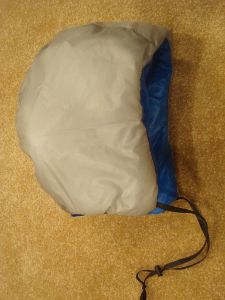 It's an insulated hat!
It's an insulated hat!It's mostly intended for sleeping when winter camping, or at elevations such as those found on the Pacific Crest or Continental Divide trails which result in freezing nighttime temperature. I was expecting to use it this winter, but we've had much warmer than normal weather.
As you can see, the hat expands and has about an inch of loft all around. The drawstring is to hold it as snug as you like.
It is reversible so I can wear it with either my blue or grey outfit and stay fashionable. :-) As a matter of fact, it is so cool, I had to wear my shades when modeling it here.
Hike On
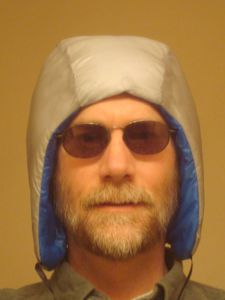
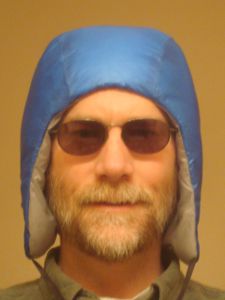
Leave Comment
Posted: 01/04/2012
Posted: 01/04/2012
01/08/2012
Can You See Me Now?
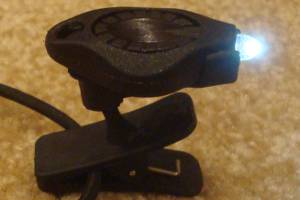 A headlamp is a great outdoors tool. It frees up both hands, lights your way or work area, and is convenient. I've got a few different ones (one I even found ontrail at Philmont) that have evolved from incandescent bulbs to LEDs, reducing the weight and power usage. But, I just got a way cool upgrade.
A headlamp is a great outdoors tool. It frees up both hands, lights your way or work area, and is convenient. I've got a few different ones (one I even found ontrail at Philmont) that have evolved from incandescent bulbs to LEDs, reducing the weight and power usage. But, I just got a way cool upgrade.I received a Photon Freedom LED light. It is a single LED but is dimmable so I can choose the brightness, and corresponding power consumption. I can't show you how bright it really is, but this tiny light delivers as much light as my previous 4 LED headlamp.
It weighs just 0.25 ounces and is as bright as my 7.6 ounce headlamp. When I add the clip, it weighs 0.4 ounces. To reduce weight, I removed the keyring, cut the tiny magnets off the clip, and left the lanyard on the table.
I'm impressed (it has a big 'fun factor') and am very excited to use it on my long hikes. I don't expect to do any night hiking, instead using it for a camp light. The clip allows the light to swivel around into any position, and is tight enough to hold it in position.
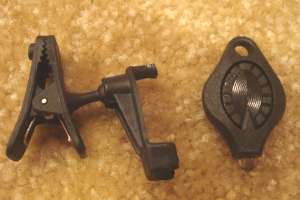 This one light should last for at least a month of hiking, but I ordered a bunch of CR2016 batteries for cheap online and will take a few, just in case. It's supposed to last from 12 to 50 hours, depending on the brightness I use. Since I expect to be in my shelter right after nightfall each day, I don't think I'll put many hours on it.
This one light should last for at least a month of hiking, but I ordered a bunch of CR2016 batteries for cheap online and will take a few, just in case. It's supposed to last from 12 to 50 hours, depending on the brightness I use. Since I expect to be in my shelter right after nightfall each day, I don't think I'll put many hours on it.I'd prefer rechargeable batteries and Photon has a version that can be recharged. There's also a solar charger accessory which could be useful, but may weigh more than carrying a few extra batteries.
I also received an ultraviolet version from my brother, concerned about scorpions on my Arizona Trail hike - he figured I could use it to see them before stepping outside or into by shoes. :-) For the extra .25 ounces, I'll probably take it along - who knows what I'll find with it.
Hike On
Leave Comment
Posted: 01/08/2012
Posted: 01/08/2012
01/11/2012
My Lil Friend
 I had a friend join me on my hike yesterday. I was very surprised to see him since he's usually just a summer hiking buddy and doesn't enjoy being out at all once it frosts up.
I had a friend join me on my hike yesterday. I was very surprised to see him since he's usually just a summer hiking buddy and doesn't enjoy being out at all once it frosts up.I can't recall if I've ever seen a mosquito out on the trail in January before, but this guy was out and about due to the record high temps this week.
Click the image if you want to see a very short video of his dance moves.
Actually, the weather has been great for getting in more hiking. I'm off now for 8 miles and it's 34°F but snow's expected and the temp drops throughout the day. Back to real January tomorrow. Unfortunately, that's not enough for the scouts going on their Okpik campout this weekend. Looks like no quinzee huts or Zero Hero awards this year. But, they've planned a 5-mile hike as an alternate activity, so that'll keep them moving and warm.
Hike On
Leave Comment
Posted: 01/11/2012
Posted: 01/11/2012
01/13/2012
SNOW
 Finally, finally, finally
Finally, finally, finallySnow, snow, snow
Well, it's actually just a dusting but we're supposed to get more tomorrow and it's just super!
When I got back from my morning hike, I just had to do this creative masterpiece in our driveway.
Hike On
Leave Comment
Posted: 01/13/2012
Posted: 01/13/2012
01/17/2012
First Pole Walk

My sons got me these Outdoor Products trek poles for Christmas and today I tried them out for the first time. Felt kind of like a 2-month old golden retriever stumbling along. I hit my foot with the pole a few times. I kicked the pole with my foot a few times. The tips skidded on the ice a few times.
Now, don't think I'm complaining here - I'm just letting you know that there's a short learning curve for any new piece of gear and gear should be used as it's needed. Today's hike was completely flat on a rails-to-trails style path. There was no need for the extra push or support from the poles - I was just taking them out for a spin. On a long hike over a stretch like this, I plan to just compress the poles and hook 'em on my pack.
When I start my hilly practice hikes, I'll tell you more about how helpful I find these poles to be. Today, I'm letting you know what we've got here.
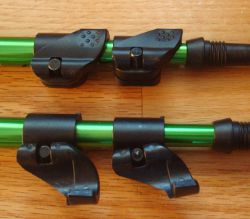 These Outdoor Products poles are aluminum with rubber handles and cam-locks. I like how the locks flip and hold rather than screw.
These Outdoor Products poles are aluminum with rubber handles and cam-locks. I like how the locks flip and hold rather than screw. There are three sections to the pole so they compress down to 25 inches which makes stowing on a pack pretty easy. The sections come completely apart so I really have 6 short aluminum tubes for emergency improvization.
After removing the rubber foot and basket, they weigh 9.7 oz. each. You can find lighter poles. I'll let you know how it feels to carry a half pound in each hand all day later.
The handles feel good to me, but the dense plastic makes them heavy.
The shafts range from 25 inches compressed to 54 inches completely extended. They have carbide tips, baskets that easily unscrew, and rubber foot covers.
I'll be using these as tarp supports on my long hikes and they seem solid enough for that extra work.
Oh, I also like the metallic green color - fits my style more than a bright red or orange pole.
At first sight, I think I got a great present here! I believe they're a good item for folks like me that haven't used trek poles before and are learning how it all works. Someone with more $$$ and experience with poles coulde easily spend more than the $30 these cost and get poles that weigh half as much.
Hike On
01/22/2012
Nighty Night
 I really, really, really want to be comfortable sleeping on my Arizona hike. Without restful sleep, I'm afraid I'll get worn out much faster. That's where this lightweight pillow becomes a necessary piece of gear. OK, necessary isn't quite true, but highly desired is.
I really, really, really want to be comfortable sleeping on my Arizona hike. Without restful sleep, I'm afraid I'll get worn out much faster. That's where this lightweight pillow becomes a necessary piece of gear. OK, necessary isn't quite true, but highly desired is.Three things make nighttime more pleasant:
- Warmth - This is the most important, for survival and rest. I told you about my sleeping hat that I made. I've got layers of clothes. And, I'll show you my sleeping quilt pretty soon.
- Safety - actually, it's feeling safe and not worrying about monsters, critters, bugs, and my position on the local food chain. Crawling under the covers will help with this. :-)
- Comfort - rocks, sticks, and cactus don't make a good mattress. I feel it's worth the weight to carry some light sleeping surface. I still need to decide on which to use. A pillow falls in this category, right?
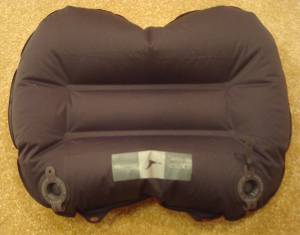 My new ExPed inflatable pillow seems practically perfect for long hikes.
My new ExPed inflatable pillow seems practically perfect for long hikes.It weighs 2.7 ounces which is a lot less than using a ball of extra clothes. (I expect to not really have extra clothes since I'll be wearing them to sleep or they'll be dirty from hiking.)
As you can see from the photo, there are two parallel lines across the face of the pillow. These are baffles connected through the pillow and they stop that balloon effect that many inflatables have. Your head doesn't always just roll off this pillow.
When deflated, it rolls up tiny and takes very little pack space.
The fabric feel is nice - not like a zip-loc baggie.
I bet it would weight .5 ounce less if it had only one valve, but ExPed has one-way flat valves on their inflatables to ensure full inflation and easy deflation. It also has a little repair kit - identical to inflatable sleeping pad repair, so I won't need to carry two repair kits.
Hike On
Older Posts Newer Posts
Find more Hiking Resources at www.HikingDude.com


Follow Me
Recent Comments